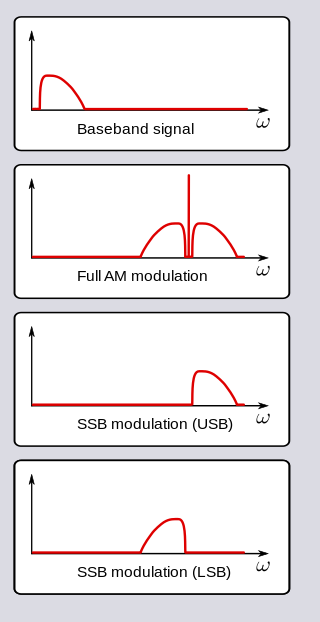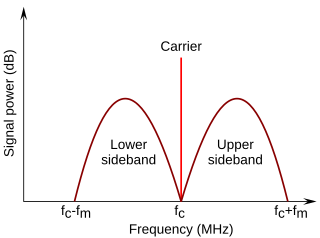
Amplitude modulation (AM) is a modulation technique used in electronic communication, most commonly for transmitting messages with a radio wave. In amplitude modulation, the amplitude of the wave is varied in proportion to that of the message signal, such as an audio signal. This technique contrasts with angle modulation, in which either the frequency of the carrier wave is varied, as in frequency modulation, or its phase, as in phase modulation.
In electronics and telecommunications, modulation is the process of varying one or more properties of a periodic waveform, called the carrier signal, with a separate signal called the modulation signal that typically contains information to be transmitted. For example, the modulation signal might be an audio signal representing sound from a microphone, a video signal representing moving images from a video camera, or a digital signal representing a sequence of binary digits, a bitstream from a computer.

In radio communications, single-sideband modulation (SSB) or single-sideband suppressed-carrier modulation (SSB-SC) is a type of modulation used to transmit information, such as an audio signal, by radio waves. A refinement of amplitude modulation, it uses transmitter power and bandwidth more efficiently. Amplitude modulation produces an output signal the bandwidth of which is twice the maximum frequency of the original baseband signal. Single-sideband modulation avoids this bandwidth increase, and the power wasted on a carrier, at the cost of increased device complexity and more difficult tuning at the receiver.

In radio communications, a sideband is a band of frequencies higher than or lower than the carrier frequency, that are the result of the modulation process. The sidebands carry the information transmitted by the radio signal. The sidebands comprise all the spectral components of the modulated signal except the carrier. The signal components above the carrier frequency constitute the upper sideband (USB), and those below the carrier frequency constitute the lower sideband (LSB). All forms of modulation produce sidebands.
Demodulation is extracting the original information-bearing signal from a carrier wave. A demodulator is an electronic circuit that is used to recover the information content from the modulated carrier wave. There are many types of modulation so there are many types of demodulators. The signal output from a demodulator may represent sound, images or binary data.

Medium wave (MW) is the part of the medium frequency (MF) radio band used mainly for AM radio broadcasting. The spectrum provides about 120 channels with more limited sound quality than FM stations on the FM broadcast band. During the daytime, reception is usually limited to more local stations, though this is dependent on the signal conditions and quality of radio receiver used. Improved signal propagation at night allows the reception of much longer distance signals. This can cause increased interference because on most channels multiple transmitters operate simultaneously worldwide. In addition, amplitude modulation (AM) is often more prone to interference by various electronic devices, especially power supplies and computers. Strong transmitters cover larger areas than on the FM broadcast band but require more energy and longer antennas. Digital modes are possible but have not reached momentum yet.

In telecommunications, a carrier wave, carrier signal, or just carrier, is a waveform that is modulated (modified) with an information-bearing signal for the purpose of conveying information.
In-band on-channel (IBOC) is a hybrid method of transmitting digital radio and analog radio broadcast signals simultaneously on the same frequency. The name refers to the new digital signals being broadcast in the same AM or FM band (in-band), and associated with an existing radio channel (on-channel). By utilizing additional digital subcarriers or sidebands, digital information is "multiplexed" on existing signals, thus avoiding re-allocation of the broadcast bands.
A subcarrier is a sideband of a radio frequency carrier wave, which is modulated to send additional information. Examples include the provision of colour in a black and white television system or the provision of stereo in a monophonic radio broadcast. There is no physical difference between a carrier and a subcarrier; the "sub" implies that it has been derived from a carrier, which has been amplitude modulated by a steady signal and has a constant frequency relation to it.
Independent sideband (ISB) is an AM single sideband mode which is used with some AM radio transmissions. Normally each sideband carries identical information, but ISB modulates two different input signals — one on the upper sideband, the other on the lower sideband. This is used in some kinds of AM stereo.

Digital Radio Mondiale is a set of digital audio broadcasting technologies designed to work over the bands currently used for analogue radio broadcasting including AM broadcasting—particularly shortwave—and FM broadcasting. DRM is more spectrally efficient than AM and FM, allowing more stations, at higher quality, into a given amount of bandwidth, using xHE-AAC audio coding format. Various other MPEG-4 and Opus codecs are also compatible, but the standard now specifies xHE-AAC.
Digital radio is the use of digital technology to transmit or receive across the radio spectrum. Digital transmission by radio waves includes digital broadcasting, and especially digital audio radio services.

In radio communications, a radio receiver, also known as a receiver, a wireless, or simply a radio, is an electronic device that receives radio waves and converts the information carried by them to a usable form. It is used with an antenna. The antenna intercepts radio waves and converts them to tiny alternating currents which are applied to the receiver, and the receiver extracts the desired information. The receiver uses electronic filters to separate the desired radio frequency signal from all the other signals picked up by the antenna, an electronic amplifier to increase the power of the signal for further processing, and finally recovers the desired information through demodulation.
AM stereo is a term given to a series of mutually incompatible techniques for radio broadcasting stereo audio in the AM band in a manner that is compatible with standard AM receivers. There are two main classes of systems: independent sideband (ISB) systems, promoted principally by American broadcast engineer Leonard R. Kahn; and quadrature amplitude modulation (QAM) multiplexing systems.

HD Radio (HDR) is a trademark for an in-band on-channel (IBOC) digital radio broadcast technology. HD radio generally simulcasts an existing analog radio station in digital format with less noise and with additional text information. HD Radio is used primarily by AM and FM radio stations in the United States, U.S. Virgin Islands, Canada, Mexico and the Philippines, with a few implementations outside North America.

FM broadcasting is a method of radio broadcasting that uses frequency modulation (FM) of the radio broadcast carrier wave. Invented in 1933 by American engineer Edwin Armstrong, wide-band FM is used worldwide to transmit high-fidelity sound over broadcast radio. FM broadcasting offers higher fidelity—more accurate reproduction of the original program sound—than other broadcasting techniques, such as AM broadcasting. It is also less susceptible to common forms of interference, having less static and popping sounds than are often heard on AM. Therefore, FM is used for most broadcasts of music and general audio. FM radio stations use the very high frequency range of radio frequencies.
Compatible Amplitude Modulation - Digital or CAM-D is a hybrid digital radio format for AM broadcasting, proposed by broadcast engineer Leonard R. Kahn.
A radio transmitter or just transmitter is an electronic device which produces radio waves with an antenna. Radio waves are electromagnetic waves with frequencies between about 30 Hz and 300 GHz. The transmitter itself generates a radio frequency alternating current, which is applied to the antenna. When excited by this alternating current, the antenna radiates radio waves. Transmitters are necessary parts of all systems that use radio: radio and television broadcasting, cell phones, wireless networks, radar, two way radios like walkie talkies, radio navigation systems like GPS, remote entry systems, among numerous other uses.

In radio, a detector is a device or circuit that extracts information from a modulated radio frequency current or voltage. The term dates from the first three decades of radio (1888-1918). Unlike modern radio stations which transmit sound on an uninterrupted carrier wave, early radio stations transmitted information by radiotelegraphy. The transmitter was switched on and off to produce long or short periods of radio waves, spelling out text messages in Morse code. Therefore, early radio receivers did not have to demodulate the radio signal, but just distinguish between the presence or absence of a radio signal, to reproduce the Morse code "dots" and "dashes". The device that performed this function in the receiver circuit was called a detector. A variety of different detector devices, such as the coherer, electrolytic detector, magnetic detector and the crystal detector, were used during the wireless telegraphy era until superseded by vacuum tube technology.
Leonard R. Kahn was an electrical engineer, who invented technology for AM broadcasting. He held over 100 patents. He was primarily known for advocating several technologies designed to improve the sound quality of AM radio. His Kahn-Hazeltine system was the chief competitor to Motorola's C-Quam AM Stereo system. More than 100 stations used his stereo system before Motorola's system ultimately won out as the AM Stereo standard. Later, a part of that system was used to develop the CAM-D AM digital broadcasting technology. His other notable inventions include maximum ratio combining used in multiple output systems. Leonard also developed the Symmetra Peak for AM radio which was used to equalize the negative and positive modulation peaks prior to the F.C.C. permitting asymmetrical modulation. Another one of Leonard's developments was a system called the Voice Line. It was a combination 4 input remote mixer and studio decoder. The system modulated a carrier at approximately 3 kHz. with the low frequency components 50 Hz-250 Hz at the remote site then demodulated the 3 kHz carrier at the studio end. This was then combined with the telephone quality audio and produced a much more natural sounding broadcast ranging from 50 Hz to as high as the telephone line would permit with the exception of the sharp notch at 3 kHz to filter out the carrier.








